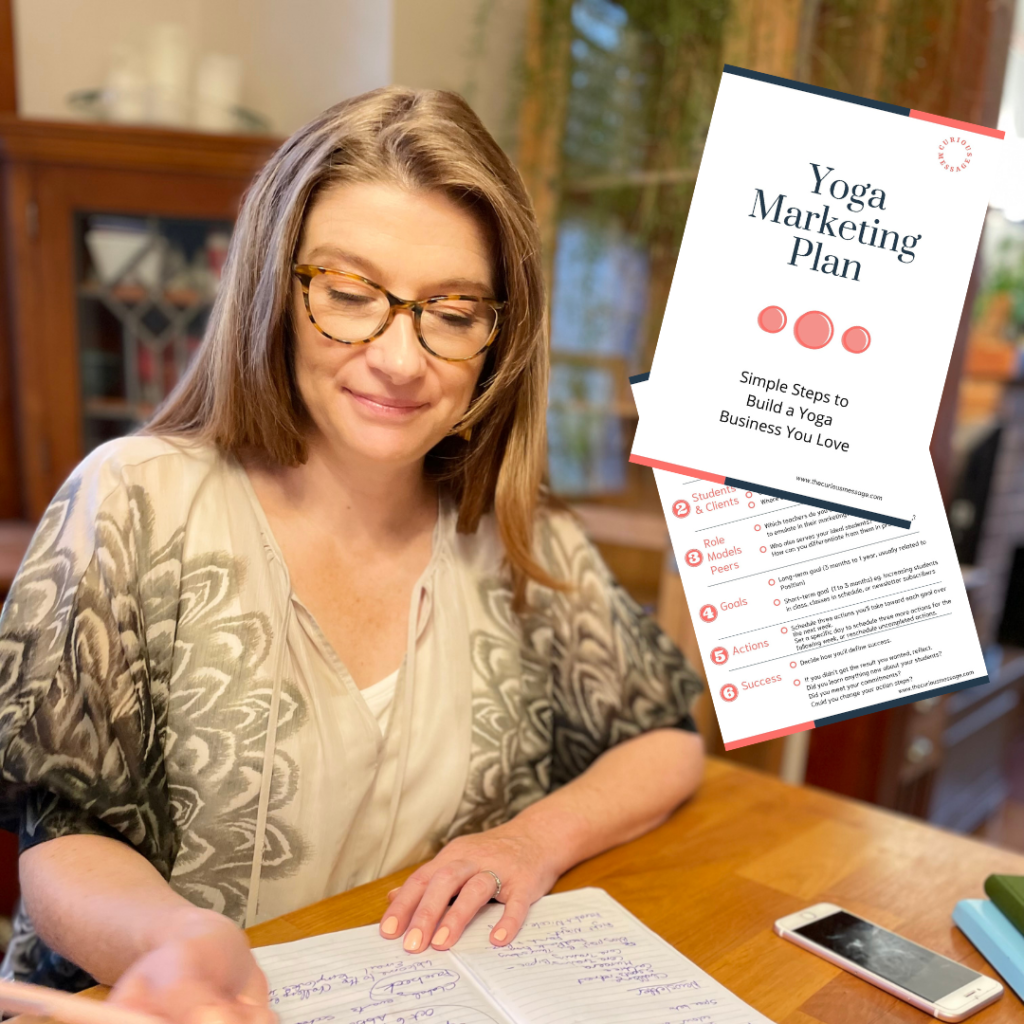Whether you’re fresh out of Yoga Teacher Training, or a seasoned Yoga studio owner, your biggest concern is probably how to fill Yoga classes. Trust me – I’ve been there. Fresh-faced and over-prepared with the perfect sequence …. only to have no one turn up for my class!! Whaaaa!
After many bouts of depression and anxiety, questioning my value as a Yoga teacher, I decided it was time to give my bruised ego a rest and put on my marketing hat.
What was the best way to get my message out and fill my yoga classes?
Yoga-fying the Standard Marketing Plan
I took a standard marketing plan template and fed it through a filter of Ahimsa and Satya. The beautiful result: A Yoga Marketing Plan that lets you be intentional and authentic in your promotions AND earn money as a Yoga teacher.

Download the template if you just want to cut to the chase. Read on for an explanation of each element.
1. Identity and Intention
In the business world, this section is called Brand and Niche. Some people are revolted by the idea of branding, so for our purposes we’ll think of it as Identity and Intention.
Think of it as your authentic self turned up louder.
What’s your Yoga Identity?

This is a little like asking, “Who are you really, deep down?” Except leaving out all the parts that don’t relate to yoga.
Before you can fill your yoga classes, you need to know your true yoga-teaching self. Not the self that can jump in and sub for anyone. But you sharing what you know best in a way makes you feel most connected to your students.
Once you know your Yoga Teacher Identity, you’re going to be able to express more of that specialness your classes, and mention only those aspects in your Yoga class promotions.
There may be people that don’t like your classical piano playlists, or the half-hour of Pranayama you always include. They’ll scroll past your Yoga ads on Instagram, and they’ll vow never to return if they stumble into one of your classes by mistake.
But if you don’t start shining forth with your true Yoga Teacher Identity you’ll never connect with those students who’ve been wishing they could spend more time on Pranayama (or whatever you’re especially skilled at). Maybe they haven’t been to a studio in years because they’re fed up with all the emphasis on Asana. And it’s your Yoga promotion with a headline of “Mostly Pranayama!” that will finally pull them back into the Yoga community.

2. Ideal students
Once you know yourself, you need to get to know your ideal students. In a business marketing plan, this section might be called Ideal Customers, Target Market or Customer Personas. I haven’t found a more “Yogic” way of saying this yet. Because Yoga philosophy is all about finding compassion for all, the idea that some students are ideal, might be off-putting.
But, stick with me…to fill your Yoga classes, you’re going to have to exclude people from your group of ideal students.
Why exclude? So that you can really focus all your attention and energy on the students who need what you’re putting out there. And so that you can release the others to find a teacher who is a better fit for them.
What’s “ideal”?
Ideal in a marketing context means the people who are most likely to resonate with your teaching style.
So if you love sharing the Sutras and including lots of Sanskrit in your cues, your ideal students will be the ones who are interested in Yoga as a philosophy. The people who care about Yoga for weight loss or as a warm up for athletic competition don’t give a hoot about Yamas and Niyamas. They just want to sweat and stretch. So putting up posters in gyms would probably be a waste of time. Either they won’t read the poster, or they’ll turn up in your class only to be disappointed.
Your ideal students are the ones who want what you’ve got. Focusing on your ideal students keeps your marketing authentic because you’re not trying to sell people on stuff they’re not interested in. You’re sending up a flare for the ones who are already looking for you.
Common Traits
Think about the traits they have in common, otherwise known as demographics. Do they tend to be teens, middle-aged, or seniors? Are they men, women, non-binary, a mix? What parts of your class do they tend to like or compliment you on? For example, they may love your guided meditations, the gentler forms, or a class with lots of active transitions and challenging shapes.
After you’ve thought about your students within a Yoga context, spend some time thinking about who they are outside the Yoga class. Do they tend to be parents? Pet owners? Business people? Artists?

3. Peers and Competitors

You try to avoid being competitive when you’re practicing Yoga. But when you’re trying to fill your Yoga classes, you have to study your competition. I’ve found it helpful to change Competitors to Peers and Competitors when I’m completing a Yoga Marketing Plan.
Who is your competition?
Make a list of five to 10 Yoga teachers (or studios) who offer your style of Yoga to your potential students. So if you’re teaching chair Yoga in Seattle, list other chair Yoga teachers in Seattle. If you’re teaching online, you’ll need to list other online chair Yoga teachers.
Check out their websites and social media accounts. Make some notes about what you like and don’t like in their marketing. How could you improve on what they’re doing? How could you emphasize your differences to appeal to students that don’t seem as well supported?

4. Goals
You might expect goals to be #1 on the list of necessary elements. The reason it comes fourth is because you can’t really figure them out until you’ve put in the work on the first three elements: Identity, Ideal Students and Competition. Sometimes, I’ll cut and paste my goals to the top of my plan after I’ve got them settled. But you always need to work on Identity and Ideal Students first.
Limit the number of goals
I’d recommend limiting yourself to two or three goals. If you’re like me, reflecting on the first three elements will have inspired dozens of goals and possibilities. But focus is key with goals. Choose one and you’ll probably accomplish it. With 10 goals, you’ll quickly run out of energy, time and money and accomplish none of them.
Identify one long-term goal related to Identity
Skip this if you’re already a seasoned teacher with a well-established identity or niche. Otherwise, this one is of prime importance. Think about what you want to be known for most, e.g. working with a particular demographic, or offering a particular style.
Brainstorm ways to establish your reputation in this area. This might include changing up your website copy or images, your promotions, or the volunteer work you’re willing to take to make connections (if it’s a new area for you).
Identify one or two short-term goals
These might include:
- Increasing the number of students in a particular class
- Getting hired at a studio or community centre
- Making a website
- Improving engagement on a social media account
- Getting people to subscribe to your newsletter
- Building a robust Yoga Marketing Plan
Short-term goals are those that you can accomplish in one to six months. They’ll support your long-term goal, or at least not work against it. And they’ll hopefully help you increase your income.

5. Action Plan

Brainstorm ways that you might accomplish each of your goals, short and long-term. Based on the information you gathered in your Identity, Ideal Students, and Competition section, evaluate your list of ideas. Choose three actions you’re going to take in the next week to a month.
These ideas should be:
- Affordable for your budget
- Realistic
- Accompanied by a deadline
For example, you might decide that you want a website to promote your Yoga business. One action could be to spend three hours before the end of the weekend researching the costs and time needed to do it yourself versus paying someone to do it for you. A second action could be writing a list of “to dos” for building the website (whether that’s interviewing designers, or choosing a web hoster and writing copy) by the end of the second week.
If you want to get a job at a Yoga studio, your actions might include writing a Yoga resume, speaking to some teachers who work there, or calling the owner. Again, give yourself a deadline!

6. Success Measurements
In the marketing department these are called KPIs, or Key Performance Indicators, and they’re how you justify your value to your boss.
As a self-employed Yoga teacher, you’re the boss! You don’t have to justify your value to anyone!
You do, however, need to pay your bills. And you probably have other delightful ways to spend your time than on self-promotion. So you’ll need a way to decide if the time and money you spent on marketing is worth the trouble. Is it worth paying someone to do it for you, or should you change your goals altogether?
For example, you might decide that you’re going to try posting more consistently on Instagram for three months to see if that draws more students to your classes.
A few different results could happen:
- You increase your class sizes to a degree you’re happy with. Posting consistently seems easy enough to keep up.
- Your class sizes increase, but the consistent Instagram posting is too draining to carry on long-term.
- There’s no change at all to class sizes, even though your followers have grown.
#1 looks like success. #2 and #3 call for a strategy adjustment. Maybe you’ll want to try different kinds of posts. You might decide to give up on Instagram, and pour more energy into Facebook, growing your email list, or putting up physical posters.
Authentic Marketing Fills Yoga Classes

At first it might seem like the world of marketing and Yoga are too far apart to work together. As a Yoga teacher, I wanted to think about putting out positive energy and attracting the gifts that were meant for me naturally.
Some types of marketing definitely don’t cooperate with that line of thinking. For instance, many advertisements work by making people feel bad about themselves and then offering a product that will make them feel better.
But marketing doesn’t have to be that way. At core, it’s simply figuring out the best way of delivering the message that you have something to offer.
Your promotions can be authentic and fill your Yoga classes, if you start out by reflecting deeply on:
- who you really are as a Yoga teacher, and
- what kinds of students already need what you’re sharing.

You can also download my Yoga Marketing Plan in a neat little package.
You might also like:
Why a Yoga marketing plan helps you put your Intention into Action.